 I first reviewed The Last of Hanako in the collection Land of Exile for Acta Koreana, and at the time I gave it too slighting a consideration, and then I reviewed it again as part of the LTI Korea Jimoondang Collection here, where I liked it better. Now, on the third time, I think I like it even more, and over time Ch’oe Yun (최윤) has really grown on me as an author, and it is a shame she seems to have retreated to her professorial tasks, and no longer writes. If you like this particular book, you should immediately run out and purchase her collection, There a Petal Silently Falls, which contains three awesome stories and was reviewed here.
I first reviewed The Last of Hanako in the collection Land of Exile for Acta Koreana, and at the time I gave it too slighting a consideration, and then I reviewed it again as part of the LTI Korea Jimoondang Collection here, where I liked it better. Now, on the third time, I think I like it even more, and over time Ch’oe Yun (최윤) has really grown on me as an author, and it is a shame she seems to have retreated to her professorial tasks, and no longer writes. If you like this particular book, you should immediately run out and purchase her collection, There a Petal Silently Falls, which contains three awesome stories and was reviewed here.
The story is simply plotted. A middle-aged man (known only as “he”), unhappy with his life, is in Venice partly in search of Jang Jin-ja, who had once served as something like muse to ‘him’ and his group of male friends. Jang was nicknamed “Hanako” (“one nose”) only after she had been expelled from the group of friends, and her real name was never spoken by them again. Hanako is an outsider who works her way in, and while her differences are cherished for a while, eventually the (male) society kicks back with cruel force. There are some extremely well written scenes including the expulsion scene, which well portrays the some-times forced nature of the Korean drinking scene (often inextricable from the larger Korean social scene).
Ch’oe plays a funny trick with names in this story – Although Hanako is a nickname (as one character remarks it sounds awfully Japanese
, considering that in Korean it would be “Ko Hana”) Hanako is the only character given a name in the entire story. The men are all known by initial which can be read as a symbol for anonymity in a society that creates facelessness, can be read as a sly reference to post-Gwangju Rebellion convention that co-conspirators must go unnamed, or both. Ch’oe is clever enough that I’m certain she has tried to achieve both effects. Although Hanako is eventually driven from Korea she is the only character given a name because she is the only character who has wherewithal to achieve her dreams. There is a sad and telling passage in which the narrator relates why he and K, another male character, are close:
Chemistry and sociology – their majors in college – had nothing to do with hats, but through sheer coincidence he and K, after stints in one or two other companies, had both settled on the hat business.
In other words, the plans and goals of their youths’ had been abandoned. Ch’oe’s message is dual-leveled: On the one hand it is an indictment of sexism and pressure for social conformity; on the other hand it is the unusual success story as Hanako/Jang Jin-ja achieves everything she wants, though at the cost of living in her homeland. Interestingly, a kind of thing that might still be necessary today, although this article refers, I believe, to kyopo.
This leads to the one part of the story that seemed forced, and that is likely a result of reviewing it years later and from a western readers’ perspective. There is a big “reveal” about Hanako’s life (which I will not spoil), which the average western reader will probably figure out after 10 pages of reading. Even if it takes more pages, the fact that the narrator constantly harps on the “unknowability” of Hanako, while describing certain specific features of her life will bring the reveal into premature reality in most readers. This still bothers me slightly, but at the time I’m sure it was rather shocking to a Korean reader and much less clear as the story developed.


